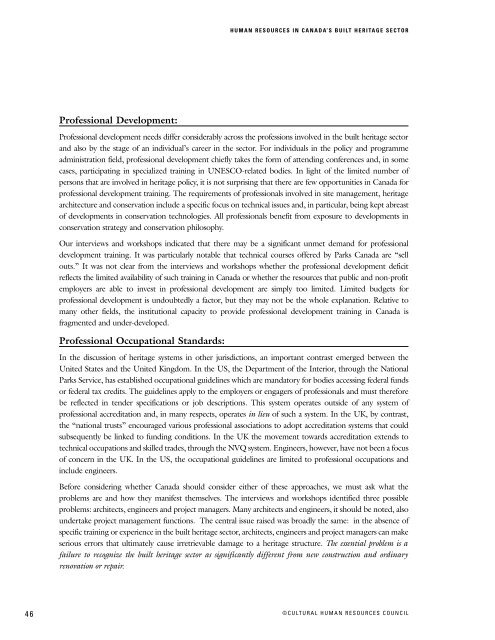Human Resources in Canada's Built Heritage Sector: Mapping the ...
Human Resources in Canada's Built Heritage Sector: Mapping the ...
Human Resources in Canada's Built Heritage Sector: Mapping the ...
- No tags were found...
Create successful ePaper yourself
Turn your PDF publications into a flip-book with our unique Google optimized e-Paper software.
HUMAN RESOURCES IN CANADA’S BUILT HERITAGE SECTORProfessional Development:Professional development needs differ considerably across <strong>the</strong> professions <strong>in</strong>volved <strong>in</strong> <strong>the</strong> built heritage sectorand also by <strong>the</strong> stage of an <strong>in</strong>dividual’s career <strong>in</strong> <strong>the</strong> sector. For <strong>in</strong>dividuals <strong>in</strong> <strong>the</strong> policy and programmeadm<strong>in</strong>istration field, professional development chiefly takes <strong>the</strong> form of attend<strong>in</strong>g conferences and, <strong>in</strong> somecases, participat<strong>in</strong>g <strong>in</strong> specialized tra<strong>in</strong><strong>in</strong>g <strong>in</strong> UNESCO-related bodies. In light of <strong>the</strong> limited number ofpersons that are <strong>in</strong>volved <strong>in</strong> heritage policy, it is not surpris<strong>in</strong>g that <strong>the</strong>re are few opportunities <strong>in</strong> Canada forprofessional development tra<strong>in</strong><strong>in</strong>g. The requirements of professionals <strong>in</strong>volved <strong>in</strong> site management, heritagearchitecture and conservation <strong>in</strong>clude a specific focus on technical issues and, <strong>in</strong> particular, be<strong>in</strong>g kept abreastof developments <strong>in</strong> conservation technologies. All professionals benefit from exposure to developments <strong>in</strong>conservation strategy and conservation philosophy.Our <strong>in</strong>terviews and workshops <strong>in</strong>dicated that <strong>the</strong>re may be a significant unmet demand for professionaldevelopment tra<strong>in</strong><strong>in</strong>g. It was particularly notable that technical courses offered by Parks Canada are “sellouts.” It was not clear from <strong>the</strong> <strong>in</strong>terviews and workshops whe<strong>the</strong>r <strong>the</strong> professional development deficitreflects <strong>the</strong> limited availability of such tra<strong>in</strong><strong>in</strong>g <strong>in</strong> Canada or whe<strong>the</strong>r <strong>the</strong> resources that public and non-profitemployers are able to <strong>in</strong>vest <strong>in</strong> professional development are simply too limited. Limited budgets forprofessional development is undoubtedly a factor, but <strong>the</strong>y may not be <strong>the</strong> whole explanation. Relative tomany o<strong>the</strong>r fields, <strong>the</strong> <strong>in</strong>stitutional capacity to provide professional development tra<strong>in</strong><strong>in</strong>g <strong>in</strong> Canada isfragmented and under-developed.Professional Occupational Standards:In <strong>the</strong> discussion of heritage systems <strong>in</strong> o<strong>the</strong>r jurisdictions, an important contrast emerged between <strong>the</strong>United States and <strong>the</strong> United K<strong>in</strong>gdom. In <strong>the</strong> US, <strong>the</strong> Department of <strong>the</strong> Interior, through <strong>the</strong> NationalParks Service, has established occupational guidel<strong>in</strong>es which are mandatory for bodies access<strong>in</strong>g federal fundsor federal tax credits. The guidel<strong>in</strong>es apply to <strong>the</strong> employers or engagers of professionals and must <strong>the</strong>reforebe reflected <strong>in</strong> tender specifications or job descriptions. This system operates outside of any system ofprofessional accreditation and, <strong>in</strong> many respects, operates <strong>in</strong> lieu of such a system. In <strong>the</strong> UK, by contrast,<strong>the</strong> “national trusts” encouraged various professional associations to adopt accreditation systems that couldsubsequently be l<strong>in</strong>ked to fund<strong>in</strong>g conditions. In <strong>the</strong> UK <strong>the</strong> movement towards accreditation extends totechnical occupations and skilled trades, through <strong>the</strong> NVQ system. Eng<strong>in</strong>eers, however, have not been a focusof concern <strong>in</strong> <strong>the</strong> UK. In <strong>the</strong> US, <strong>the</strong> occupational guidel<strong>in</strong>es are limited to professional occupations and<strong>in</strong>clude eng<strong>in</strong>eers.Before consider<strong>in</strong>g whe<strong>the</strong>r Canada should consider ei<strong>the</strong>r of <strong>the</strong>se approaches, we must ask what <strong>the</strong>problems are and how <strong>the</strong>y manifest <strong>the</strong>mselves. The <strong>in</strong>terviews and workshops identified three possibleproblems: architects, eng<strong>in</strong>eers and project managers. Many architects and eng<strong>in</strong>eers, it should be noted, alsoundertake project management functions. The central issue raised was broadly <strong>the</strong> same: <strong>in</strong> <strong>the</strong> absence ofspecific tra<strong>in</strong><strong>in</strong>g or experience <strong>in</strong> <strong>the</strong> built heritage sector, architects, eng<strong>in</strong>eers and project managers can makeserious errors that ultimately cause irretrievable damage to a heritage structure. The essential problem is afailure to recognize <strong>the</strong> built heritage sector as significantly different from new construction and ord<strong>in</strong>aryrenovation or repair.46©CULTURAL HUMAN RESOURCES COUNCIL










